Performance Analysis of Precipitation Datasets at Multiple Spatio-Temporal Scales over Dense Gauge Network in Mountainous Domain of Tajikistan, Central Asia
Abstract
1. Introduction
2. Materials and Methods
2.1. Study Region
2.2. Datasets
2.3. Methods
3. Results
3.1. Spatial and Temporal Capability of SBPD
3.2. Ability of SBPD on a Daily Scale
3.3. Ability of SBPD on a Monthly Scale
3.4. Ability of SBPD on a Seasonal Scale
4. Discussion
5. Conclusions
- On a monthly scale, the performance of all SBPD is more analogous to gauge estimations compared to on a daily scale.
- The IMERG capability to track the spatiotemporal variability over the mountainous domain of Central Asia (Tajikistan) is unmatchable compared to other selected datasets (CDR, TRMM, and CCS).
- In high-elevated areas, IMERG performance is more satisfactory compared to other datasets. While the performance of TRMM and PERSIANN-CDR is reasonable on flat sites, the performance of CCS is unacceptable.
- In terms of probability of detection (POD), the IMERG outperforms all other SBPD (TRMM, CCS, and CDR) in all seasons, except in the winter season, with ranges (>0.71 in all seasons). While the false alarm ratio (FAR) is minimal for the IMERG product.
- The TRMM displays a significant amount of overestimation (80%) in response to tracking daily light precipitation events. The CDR exhibits significant underestimation (−52%), while the performance of IMERG is catchable by the in situ gauge observations in all seasons and on daily scales. Moreover, all SBPDs show more variability in tracking light precipitation events compared to medium and high precipitation events.
- The PERSIANN-CCS performance is only satisfactory in the spring season. The IMERG outperforms all other products in all seasons.
- All SBPD illustrate underestimations during the summer season, with the most significant underestimation displayed by CDR (−60%) in summer. The TRMM product displays significant underestimation (−40%) in the spring season, and significant overestimation in the winter season (43%).
- On annual estimations, the performance of IMERG is not satisfactory compared to other scales (daily, monthly, and seasonal). However, IMERG dominates all other SBPDs to track spatiotemporal variability over a limited gauge network of Tajikistan.
- Generally, the CC values between SBPD and gauge estimations increase with the increase in precipitation intensity. Conversely, the relationship between the gauge and SBPD decreases at higher altitudes.
Author Contributions
Funding
Data Availability Statement
Acknowledgments
Conflicts of Interest
References
- Shukla, S.; Kansal, M.L.; Jain, S.K. Snow Cover Area Variability Assessment in the Upper Part of the Satluj River Basin in India. Geocarto Int. 2016, 32, 1285–1306. [Google Scholar] [CrossRef]
- Souza, J.; Gonçalves, W.A.; Souza, D.O. De Evaluation of Atmospheric Features in Natural Disasters Due Frontal Systems over Southern Brazil. Atmosphere 2022, 13, 1886. [Google Scholar]
- Nadeem, M.U.; Waheed, Z.; Ghaffar, A.M.; Javaid, M.M.; Hamza, A.; Ayub, Z.; Nawaz, M.A.; Waseem, W.; Hameed, M.F.; Zeeshan, A.; et al. Application of HEC-HMS for Flood Forecasting in Hazara Catchment Pakistan, South Asia. Int. J. Hydrol. 2022, 6, 7–12. [Google Scholar] [CrossRef]
- Roebber, P.J. Visualizing Multiple Measures of Forecast Quality. Weather. Forecast. 2009, 24, 601–608. [Google Scholar] [CrossRef]
- Cheema, M.J.M.; Bastiaanssen, W.G.M. Local calibration of remotely sensed rainfall from the TRMM satellite for different periods and spatial scales in the Indus Basin. Int. J. Remote Sens. 2011, 33, 2603–2627. [Google Scholar] [CrossRef]
- Anjum, M.N.; Ding, Y.; Shangguan, D.; Ijaz, M.W.; Zhang, S. Evaluation of High-Resolution Satellite-Based Real-Time and Post-Real-Time Precipitation Estimates during 2010 Extreme Flood Event in Swat River Basin, Hindukush Region. Adv. Meteorol. 2016, 2016, 2604980. [Google Scholar] [CrossRef]
- Yang, M.; Li, Z.; Anjum, M.N.; Gao, Y. Performance Evaluation of Version 5 (V05) of Integrated Multi-Satellite Retrievals for Global Precipitation Measurement (IMERG) over the Tianshan Mountains of China. Water 2019, 11, 1139. [Google Scholar] [CrossRef]
- Abebe, S.A.; Qin, T.; Yan, D.; Gelaw, E.B.; Workneh, H.T.; Kun, W.; Shanshan, L.; Biqiong, D. Spatial and Temporal Evaluation of the Latest High-Resolution Precipitation Products over the Upper Blue Nile River Basin, Ethiopia. Water 2020, 12, 3072. [Google Scholar] [CrossRef]
- Wild, A.; Chua, Z.W.; Kuleshov, Y. Evaluation of Satellite Precipitation Estimates over the South West Pacific Region. Remote Sens. 2021, 13, 3929. [Google Scholar] [CrossRef]
- Sharifi, E.; Eitzinger, J.; Dorigo, W. Performance of the State-of-the-Art Gridded Precipitation Products over Mountainous Terrain: A Regional Study over Austria. Remote Sens. 2019, 11, 2018. [Google Scholar] [CrossRef]
- Nadeem, M.U.; Anjum, M.N.; Asif, M.; Iqbal, T.; Hussain, S.; Sarwar, H.R.A.; Abbas, A. Spatio-Temporal Assessment of Satellite-Based Precipitation Products for Hydroclimatic Applications over over Potohar Region, Pakistan. Environ. Sci. Proc. 2022, 23, 18. [Google Scholar]
- Anjum, M.N.; Irfan, M.; Waseem, M.; Leta, M.K.; Niazi, U.M.; Rahman, S.; Ghanim, A.; Mukhtar, M.A.; Nadeem, M.U. Assessment of PERSIANN-CCS, PERSIANN-CDR, SM2RAIN-ASCAT, and CHIRPS-2.0 Rainfall Products over a Semi-Arid Subtropical Climatic Region. Water 2022, 14, 147. [Google Scholar] [CrossRef]
- Bhati, D.S.; Dubey, S.K.; Sharma, D. Application of Satellite-Based and Observed Precipitation Datasets for Hydrological Simulation in the Upper Mahi River Basin of Rajasthan, India. Sustainability 2021, 13, 7560. [Google Scholar] [CrossRef]
- Gulakhmadov, A.; Chen, X.; Gulakhmadov, M.; Kobuliev, Z.; Gulahmadov, N.; Peng, J.; Li, Z.; Liu, T. Correction: Gulakhmadov et al. Evaluation of the CRU TS3.1, APHRODITE_V1101, and CFSR Datasets in Assessing Water Balance Components in the Upper Vakhsh River Basin in Central Asia. Atmosphere 2021, 12, 1334, Erratum in Atmosphere 2021, 12, 1641. [Google Scholar] [CrossRef]
- Gulakhmadov, A.; Chen, X.; Gulahmadov, N.; Liu, T.; Anjum, M.N.; Rizwan, M. Simulation of the Potential Impacts of Projected Climate Change on Streamflow in the Vakhsh River Basin in Central Asia under CMIP5 RCP Scenarios. Water 2020, 12, 1426. [Google Scholar] [CrossRef]
- Huang, W.-R.; Liu, P.-Y.; Hsu, J. Multiple Timescale Assessment of Wet Season Precipitation Estimation over Taiwan Using the PERSIANN Family Products. Int. J. Appl. Earth Obs. Geoinf. 2021, 103, 102521. [Google Scholar] [CrossRef]
- Jiang, X.; Liu, Y.; Wu, Y.; Wang, G.; Zhang, X.; Meng, Q.; Gu, P.; Liu, T. Evaluation of the Performance of Multi-Source Precipitation Data in Southwest China. Water 2021, 13, 3200. [Google Scholar] [CrossRef]
- Beck, H.E.; Vergopolan, N.; Pan, M.; Levizzani, V.; van Dijk, A.I.J.M.; Weedon, G.P.; Brocca, L.; Pappenberger, F.; Huffman, G.J.; Wood, E.F. Global-Scale Evaluation of 22 Precipitation Datasets Using Gauge Observations and Hydrological Modeling. Hydrol. Earth Syst. Sci. 2017, 21, 6201–6217. [Google Scholar] [CrossRef]
- Berthier, E.; Arnaud, Y.; Kumar, R.; Ahmad, S.; Wagnon, P.; Chevallier, P. Remote Sensing Estimates of Glacier Mass Balances in the Himachal Pradesh (Western Himalaya, India). Remote Sens. Environ. 2007, 108, 327–338. [Google Scholar] [CrossRef]
- Salmani-Dehaghi, N.; Samani, N. Development of Bias-Correction PERSIANN-CDR Models for the Simulation and Completion of Precipitation Time Series. Atmos. Environ. 2020, 246, 117981. [Google Scholar] [CrossRef]
- Talchabhadel, R.; Aryal, A.; Kawaike, K.; Yamanoi, K.; Nakagawa, H.; Bhatta, B.; Karki, S.; Thapa, B.R. Evaluation of Precipitation Elasticity Using Precipitation Data from Ground and Satellite-Based Estimates and Watershed Modeling in Western Nepal. J. Hydrol. Reg. Stud. 2020, 33, 100768. [Google Scholar] [CrossRef]
- Sadeghi, M.; Nguyen, P.; Naeini, M.R.; Hsu, K.; Braithwaite, D.; Sorooshian, S. PERSIANN-CCS-CDR, a 3-Hourly 0.04° Global Precipitation Climate Data Record for Heavy Precipitation Studies. Sci. Data 2021, 8, 1–11. [Google Scholar] [CrossRef] [PubMed]
- Katiraie-Boroujerdy, P.-S.; Asanjan, A.A.; Hsu, K.-L.; Sorooshian, S. Intercomparison of PERSIANN-CDR and TRMM-3B42V7 precipitation estimates at monthly and daily time scales. Atmos. Res. 2017, 193, 36–49. [Google Scholar] [CrossRef]
- Dhanesh, Y.; Bindhu, V.M.; Senent-Aparicio, J.; Brighenti, T.M.; Ayana, E.; Smitha, P.S.; Fei, C.; Srinivasan, R. A Comparative Evaluation of the Performance of CHIRPS and CFSR Data for Different Climate Zones Using the SWAT Model. Remote Sens. 2020, 12, 3088. [Google Scholar] [CrossRef]
- Vu, T.T.; Li, L.; Jun, K.S. Evaluation of Multi-Satellite Precipitation Products for Streamflow Simulations: A Case Study for the Han River Basin in the Korean Peninsula, East Asia. Water 2018, 10, 642. [Google Scholar] [CrossRef]
- Anjum, M.N.; Ahmad, I.; Ding, Y.; Shangguan, D.; Zaman, M.; Ijaz, M.W.; Sarwar, K.; Han, H.; Yang, M. Assessment of IMERG-V06 Precipitation Product over Different Hydro-Climatic Regimes in the Tianshan Mountains, North-Western China. Remote Sens. 2019, 11, 2314. [Google Scholar] [CrossRef]
- Nguyen, P.; Shearer, E.J.; Tran, H.; Ombadi, M.; Hayatbini, N.; Palacios, T.; Huynh, P.; Braithwaite, D.; Updegraff, G.; Hsu, K.; et al. The CHRS Data Portal, an Easily Accessible Public Repository for PERSIANN Global Satellite Precipitation Data. Sci. Data 2019, 6, 180296. [Google Scholar] [CrossRef]
- Rahman, S.H.; Sengupta, D.; Ravichandran, M. Variability of Indian Summer Monsoon Rainfall in Daily Data from Gauge and Satellite. J. Geophys. Res. Atmos. 2009, 114. [Google Scholar] [CrossRef]
- Zhang, L.; Li, X.; Zheng, D.; Zhang, K.; Ma, Q.; Zhao, Y.; Ge, Y. Merging Multiple Satellite-Based Precipitation Products and Gauge Observations Using a Novel Double Machine Learning Approach. J. Hydrol. 2021, 594, 125969. [Google Scholar] [CrossRef]
- Asif, M.; Nadeem, M.U.; Anjum, M.N.; Ahmad, B.; Manuchekhr, G.; Umer, M.; Hamza, M.; Javaid, M.M. Evaluation of Soil Moisture-Based Satellite Precipitation Products over Semi-Arid Climatic Region. Atmosphere 2022, 14, 8. [Google Scholar] [CrossRef]
- Hamza, A.; Anjum, M.N.; Cheema, M.J.M.; Chen, X.; Afzal, A.; Azam, M.; Shafi, M.K.; Gulakhmadov, A. Assessment of IMERG-V06, TRMM-3B42V7, SM2RAIN-ASCAT, and PERSIANN-CDR Precipitation Products over the Hindu Kush Mountains of Pakistan, South Asia. Remote Sens. 2020, 12, 3871. [Google Scholar] [CrossRef]
- Nadeem, M.U.; Anjum, M.N.; Afzal, A.; Azam, M.; Hussain, F.; Usman, M.; Javaid, M.M.; Mukhtar, M.A.; Majeed, F. Assessment of Multi-Satellite Precipitation Products over the Himalayan Mountains of Pakistan, South Asia. Sustainability 2022, 14, 8490. [Google Scholar] [CrossRef]
- Ahmed, E.; Al Janabi, F.; Zhang, J.; Yang, W.; Saddique, N.; Krebs, P. Hydrologic Assessment of TRMM and GPM-Based Precipitation Products in Transboundary River Catchment (Chenab River, Pakistan). Water 2020, 12, 1902. [Google Scholar] [CrossRef]
- Anjum, M.N.; Ding, Y.; Shangguan, D.; Tahir, A.A.; Iqbal, M.; Adnan, M. Comparison of Two Successive Versions 6 and 7 of TMPA Satellite Precipitation Products with Rain Gauge Data over Swat Watershed, Hindukush Mountains, Pakistan. Atmos. Sci. Lett. 2016, 17, 270–279. [Google Scholar] [CrossRef]
- Lu, X.; Tang, G.; Liu, X.; Wang, X.; Liu, Y.; Wei, M. The Potential and Uncertainty of Triple Collocation in Assessing Satellite Precipitation Products in Central Asia. Atmos. Res. 2021, 252, 105452. [Google Scholar] [CrossRef]
- Gao, F.; Zhang, Y.; Chen, Q.; Wang, P.; Yang, H.; Yao, Y.; Cai, W. Comparison of Two Long-Term and High-Resolution Satellite Precipitation Datasets in Xinjiang, China. Atmos. Res. 2018, 212, 150–157. [Google Scholar] [CrossRef]
- Mosaffa, H.; Shirvani, A.; Khalili, D.; Nguyen, P.; Sorooshian, S. Post and near Real-Time Satellite Precipitation Products Skill over Karkheh River Basin in Iran. Int. J. Remote Sens. 2020, 41, 6484–6502. [Google Scholar] [CrossRef]
- Chen, C.; Chen, Q.; Duan, Z.; Zhang, J.; Mo, K.; Li, Z.; Tang, G. Multiscale Comparative Evaluation of the GPM IMERG v5 and TRMM 3B42 v7 Precipitation Products from 2015 to 2017 over a Climate Transition Area of China. Remote Sens. 2018, 10, 944. [Google Scholar] [CrossRef]
- Fu, Y.; Xia, J.; Yuan, W.; Xu, B.; Wu, X.; Chen, Y.; Zhang, H. Assessment of Multiple Precipitation Products over Major River Basins of China. Theor. Appl. Clim. 2014, 123, 11–22. [Google Scholar] [CrossRef]
- Bagtasa, G. Assessment of Tropical Cyclone Rainfall from GSMaP and GPM Products and Their Application to Analog Forecasting in the Philippines. Atmosphere 2022, 13, 1398. [Google Scholar] [CrossRef]
- Pellarin, T.; Román-Cascón, C.; Baron, C.; Bindlish, R.; Brocca, L.; Camberlin, P.; Fernández-Prieto, D.; Kerr, Y.H.; Massari, C.; Panthou, G.; et al. The Precipitation Inferred from Soil Moisture (PrISM) near Real-Time Rainfall Product: Evaluation and Comparison. Remote Sens. 2020, 12, 481. [Google Scholar] [CrossRef]
- Iqbal, M.F.; Athar, H. Validation of Satellite Based Precipitation over Diverse Topography of Pakistan. Atmos. Res. 2018, 201, 247–260. [Google Scholar] [CrossRef]
- Nadeem, M.U.; Ghanim, A.A.J.; Anjum, M.N.; Shangguan, D.; Rasool, G.; Irfan, M.; Niazi, U.M.; Hassan, S. Multiscale Ground Validation of Satellite and Reanalysis Precipitation Products over Diverse Climatic and Topographic Conditions. Remote Sens. 2022, 14, 4680. [Google Scholar] [CrossRef]
- Hussain, S.; Song, X.; Ren, G.; Hussain, I.; Han, D.; Zaman, M.H. Evaluation of Gridded Precipitation Data in the Hindu Kush–Karakoram–Himalaya Mountainous Area. Hydrol. Sci. J. 2017, 62, 2393–2405. [Google Scholar] [CrossRef]
- Peng, J.; Liu, T.; Huang, Y.; Ling, Y.; Li, Z.; Bao, A.; Chen, X.; Kurban, A.; De Maeyer, P. Satellite-Based Precipitation Datasets Evaluation Using Gauge Observation and Hydrological Modeling in a Typical Arid Land Watershed of Central Asia. Remote Sens. 2021, 13, 221. [Google Scholar] [CrossRef]
- Ali, S.; Chen, Y.; Azmat, M.; Kayumba, P.M.; Ahmed, Z.; Mind’je, R.; Ghaffar, A.; Qin, J.; Tariq, A. Long-Term Performance Evaluation of the Latest Multi-Source Weighted-Ensemble Precipitation (MSWEP) over the Highlands of Indo-Pak (1981–2009). Remote Sens. 2022, 14, 4773. [Google Scholar] [CrossRef]
- Habib, E.; Haile, A.T.; Sazib, N.; Zhang, Y.; Rientjes, T. Effect of Bias Correction of Satellite-Precipitation Estimates on Runoff Simulations at the Source of the Upper Blue Nile. Remote Sens. 2014, 6, 6688–6708. [Google Scholar] [CrossRef]
- Li, Z.; Wen, Y.; Schreier, M.; Behrangi, A.; Hong, Y.; Lambrigtsen, B. Advancing Satellite Precipitation Retrievals With Data Driven Approaches: Is Black Box Model Explainable? Earth Space Sci. 2021, 8, e2020EA001423. [Google Scholar] [CrossRef]
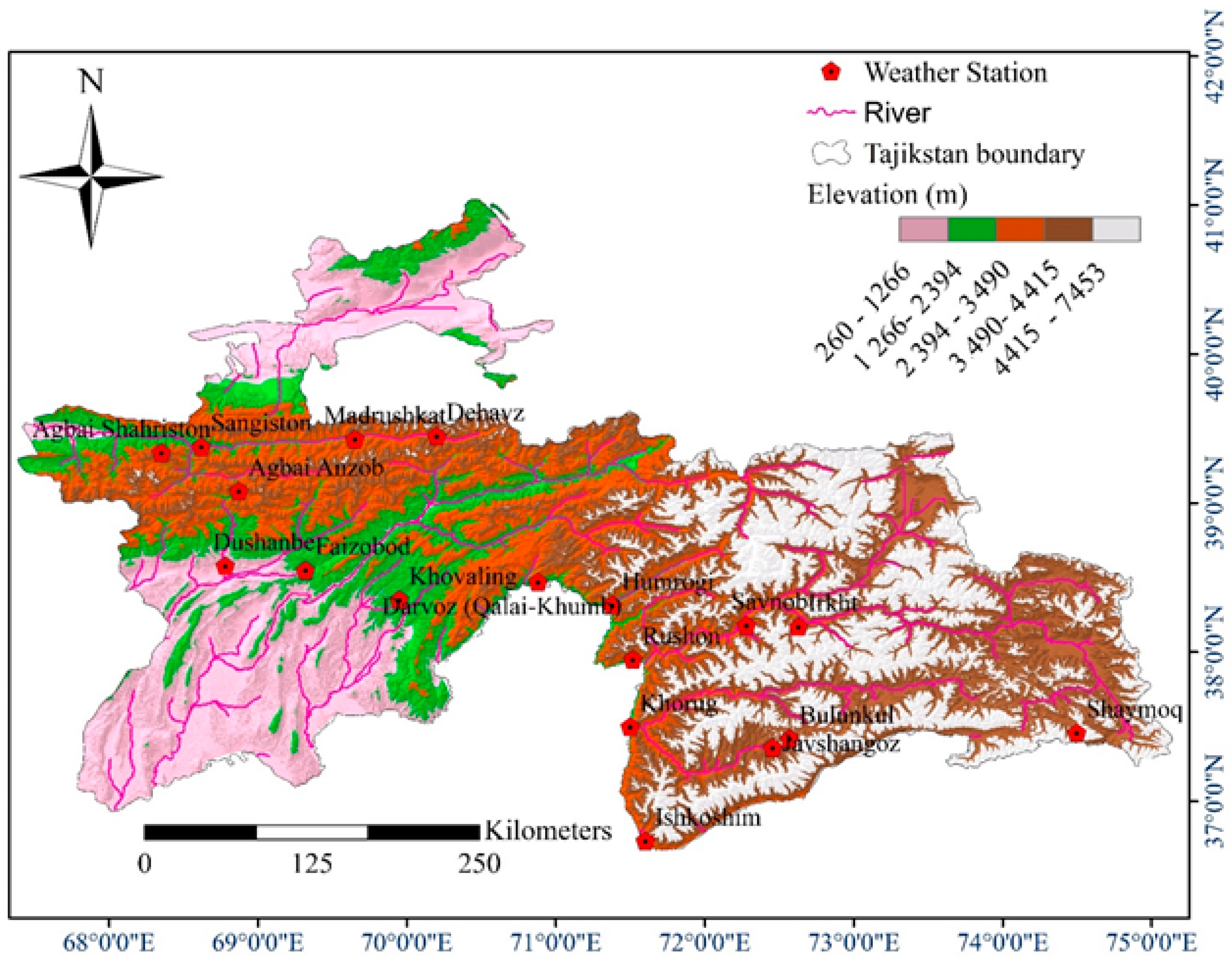
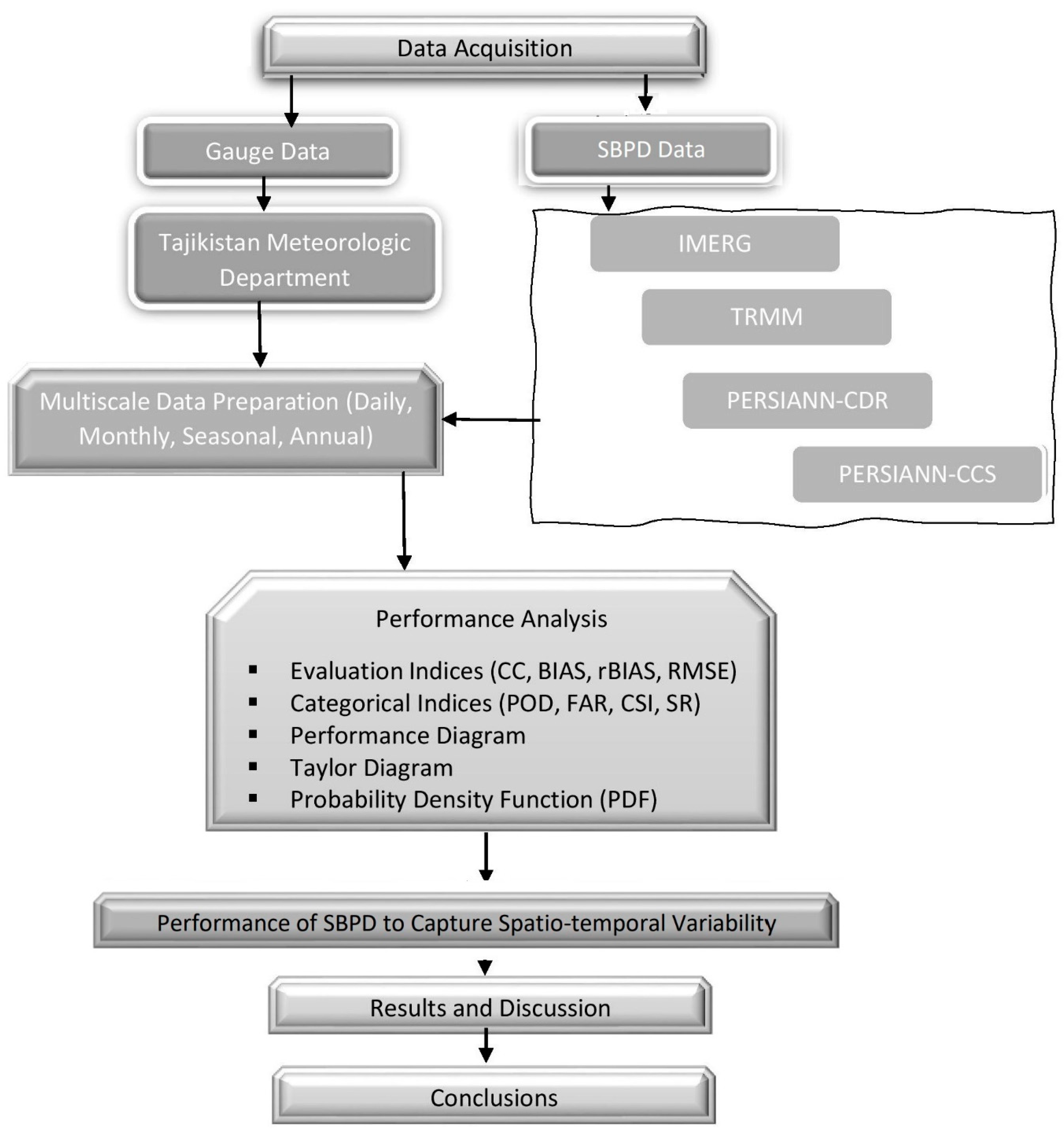
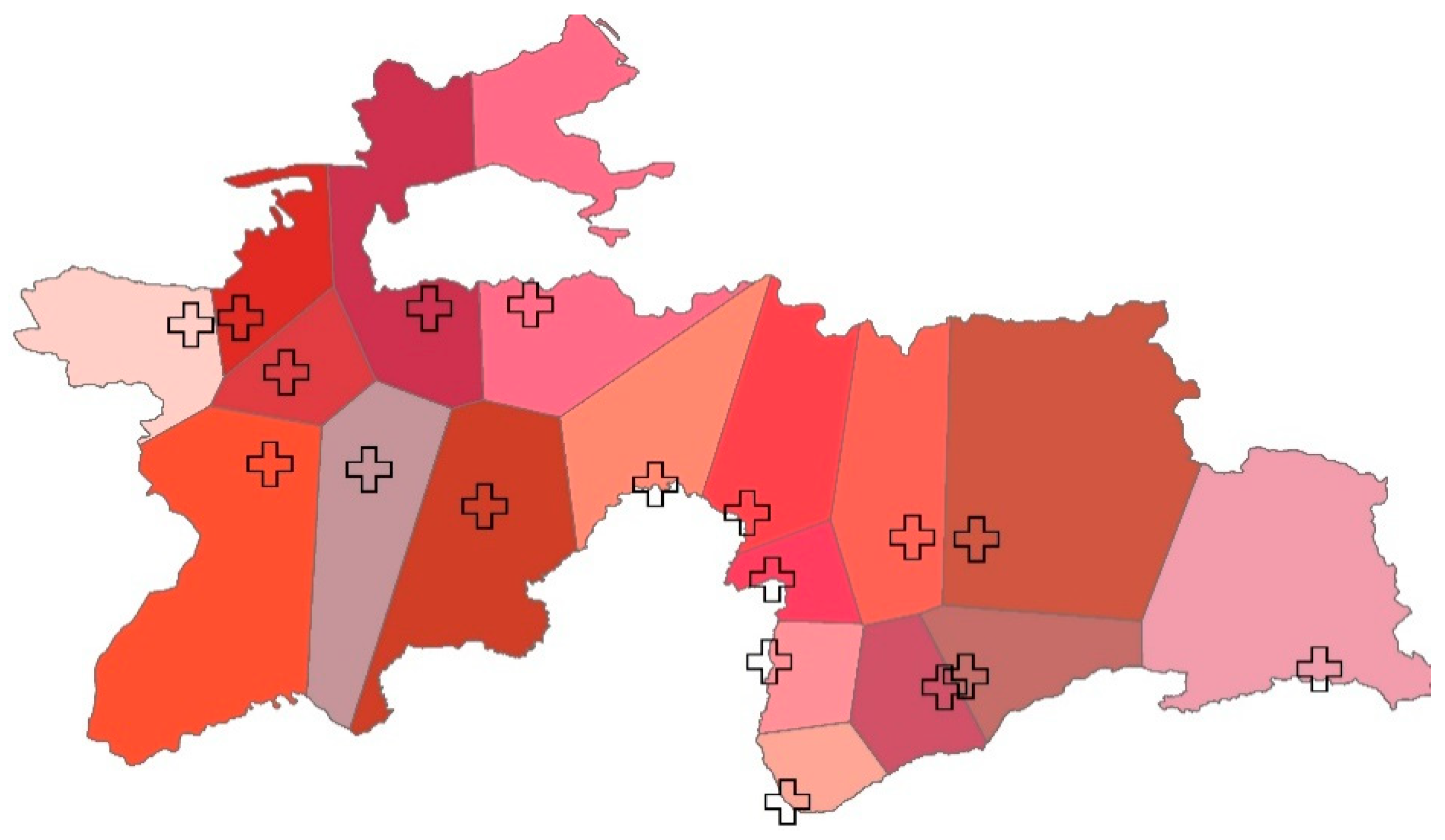
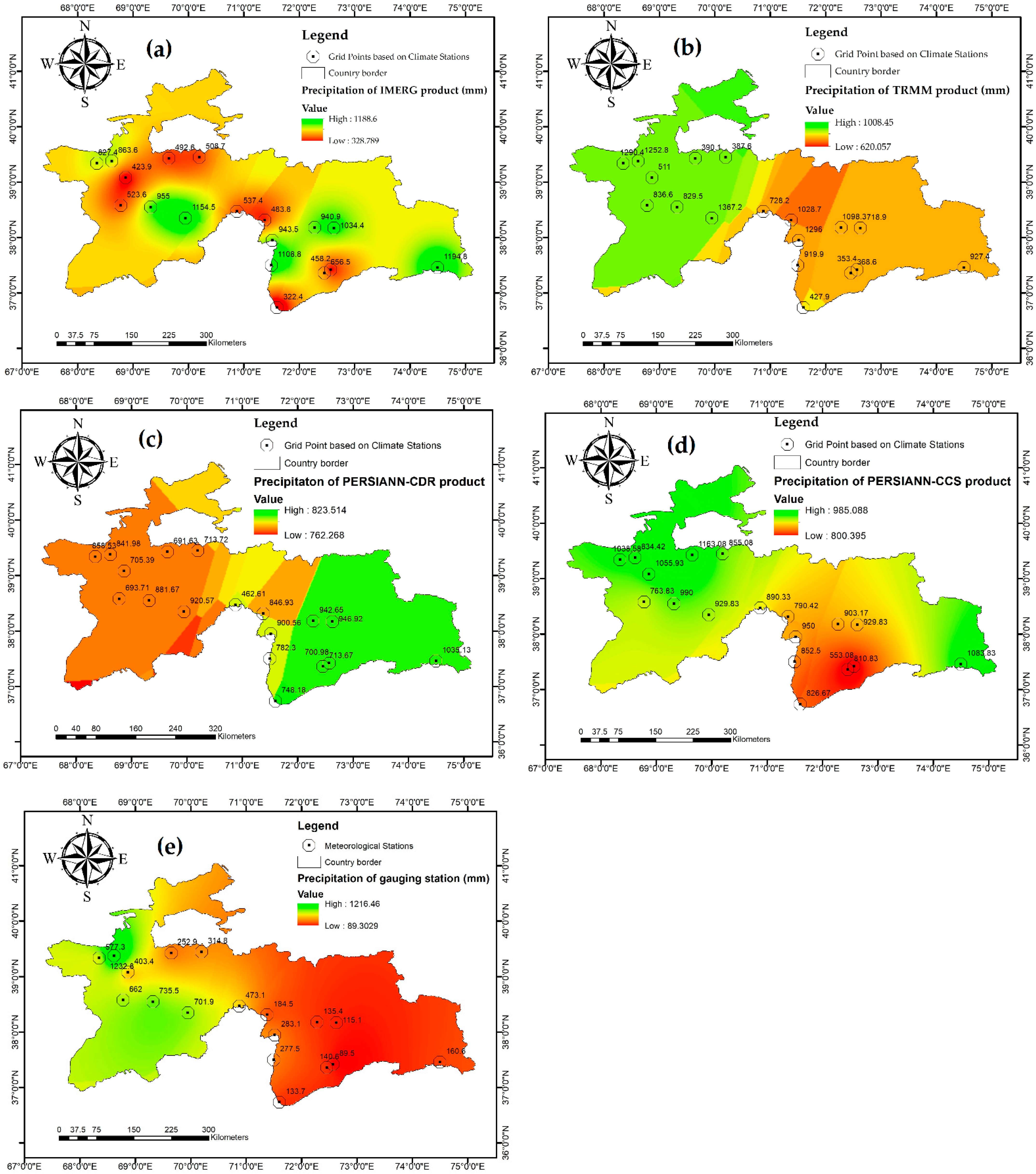
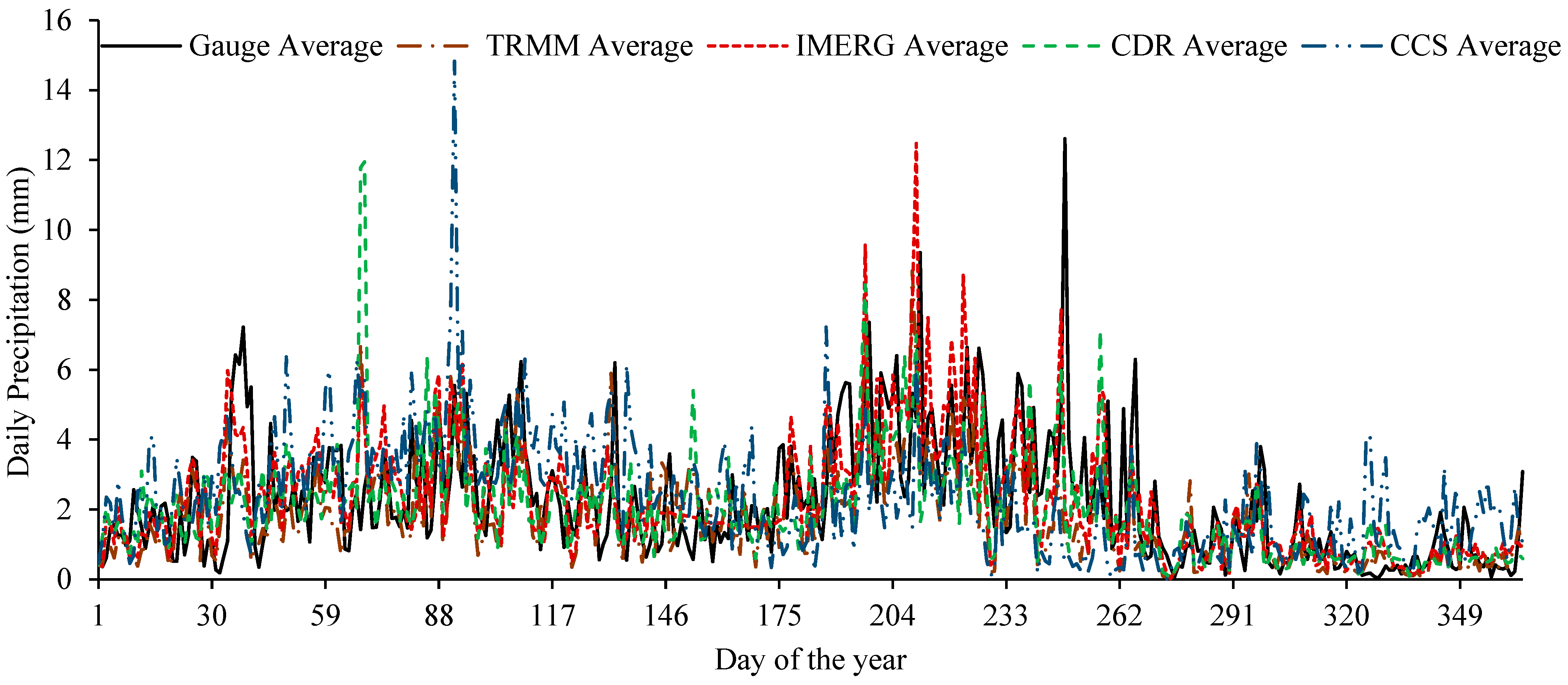
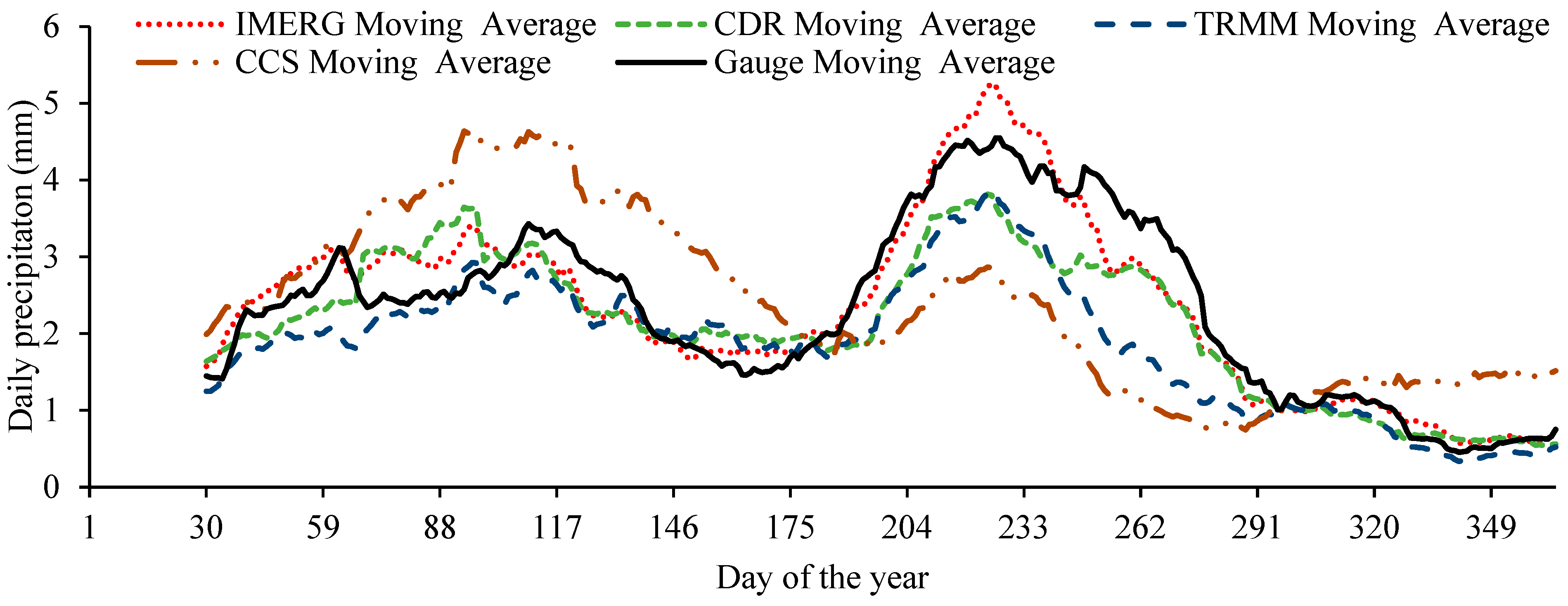



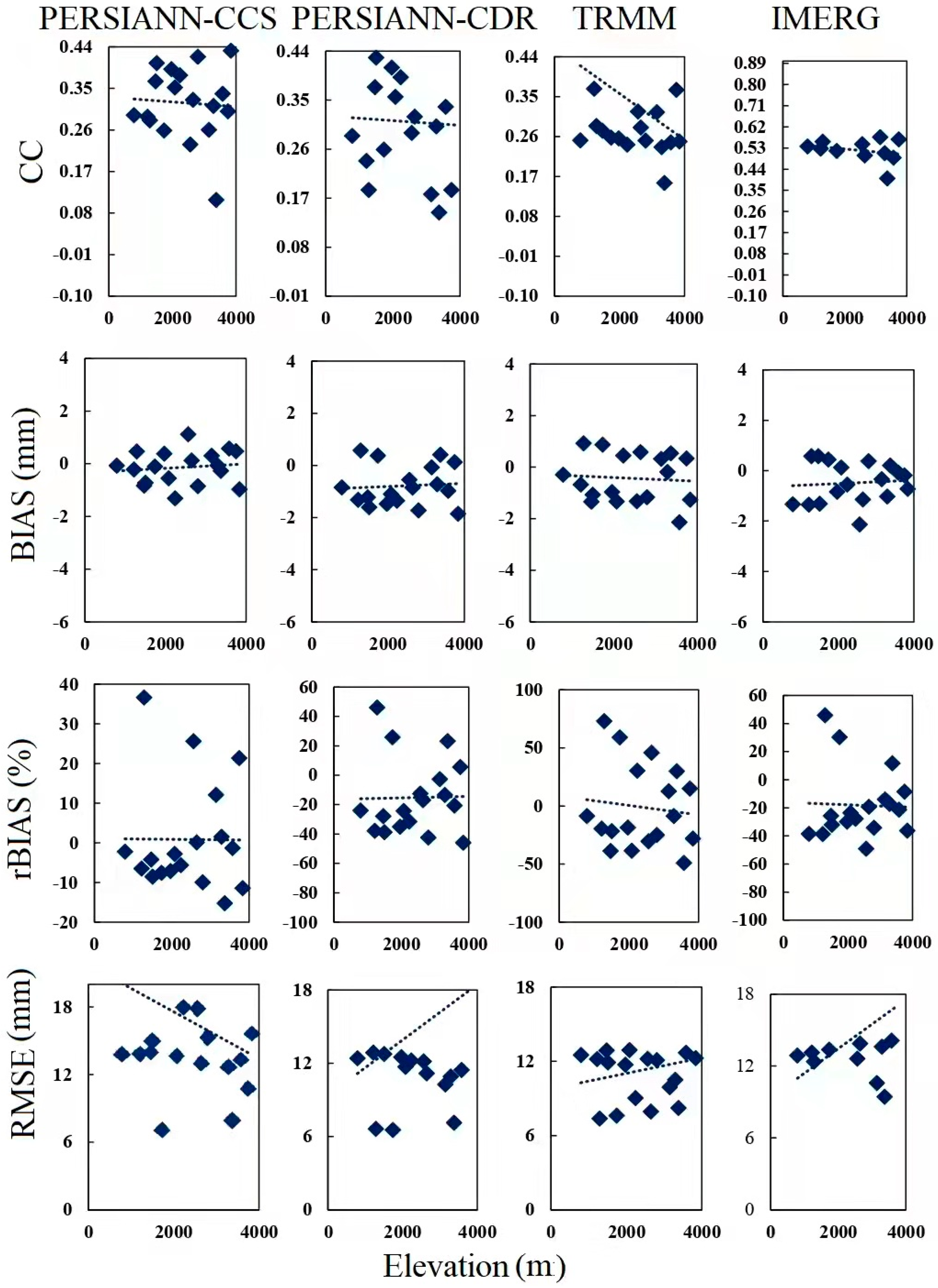

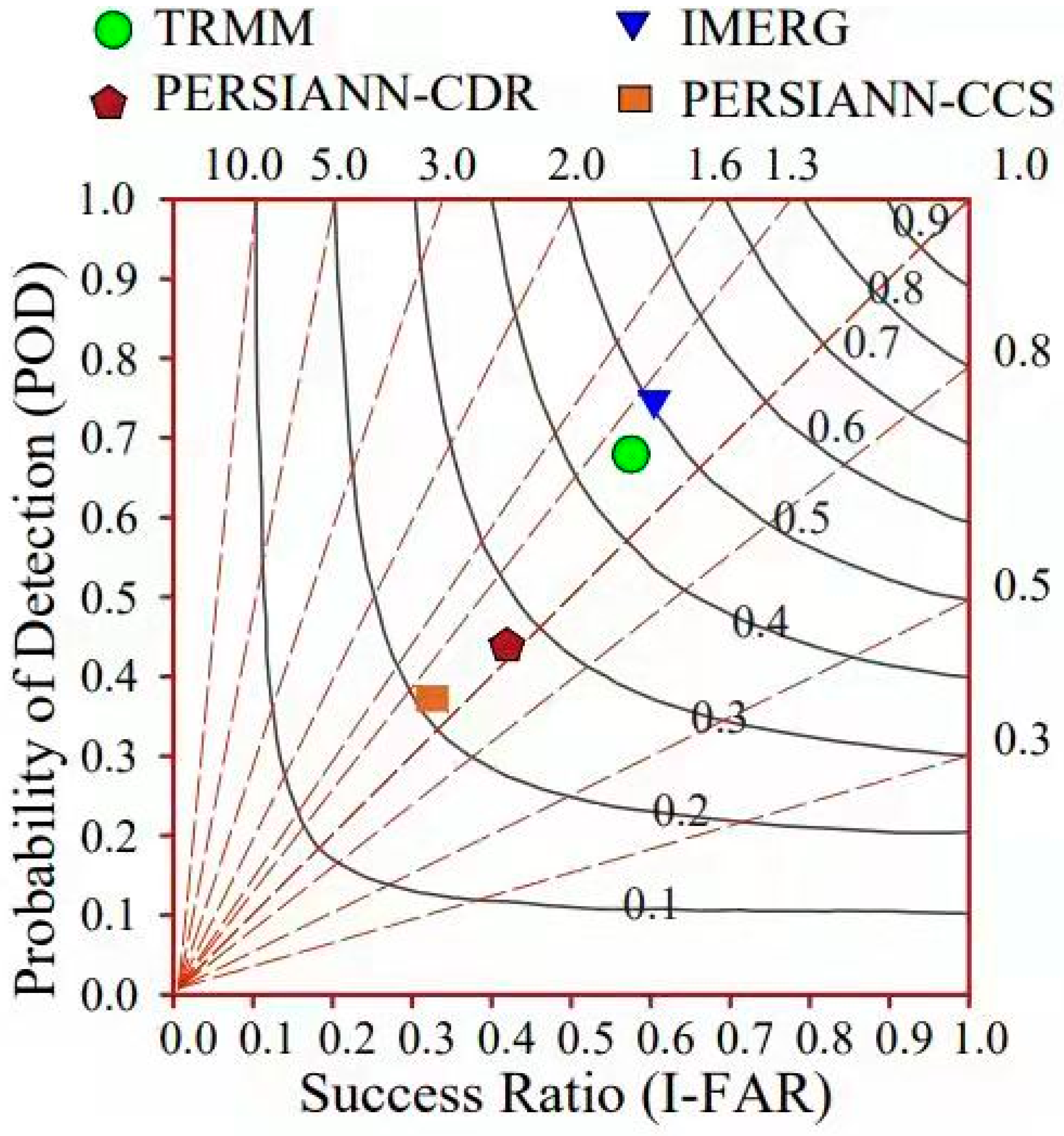


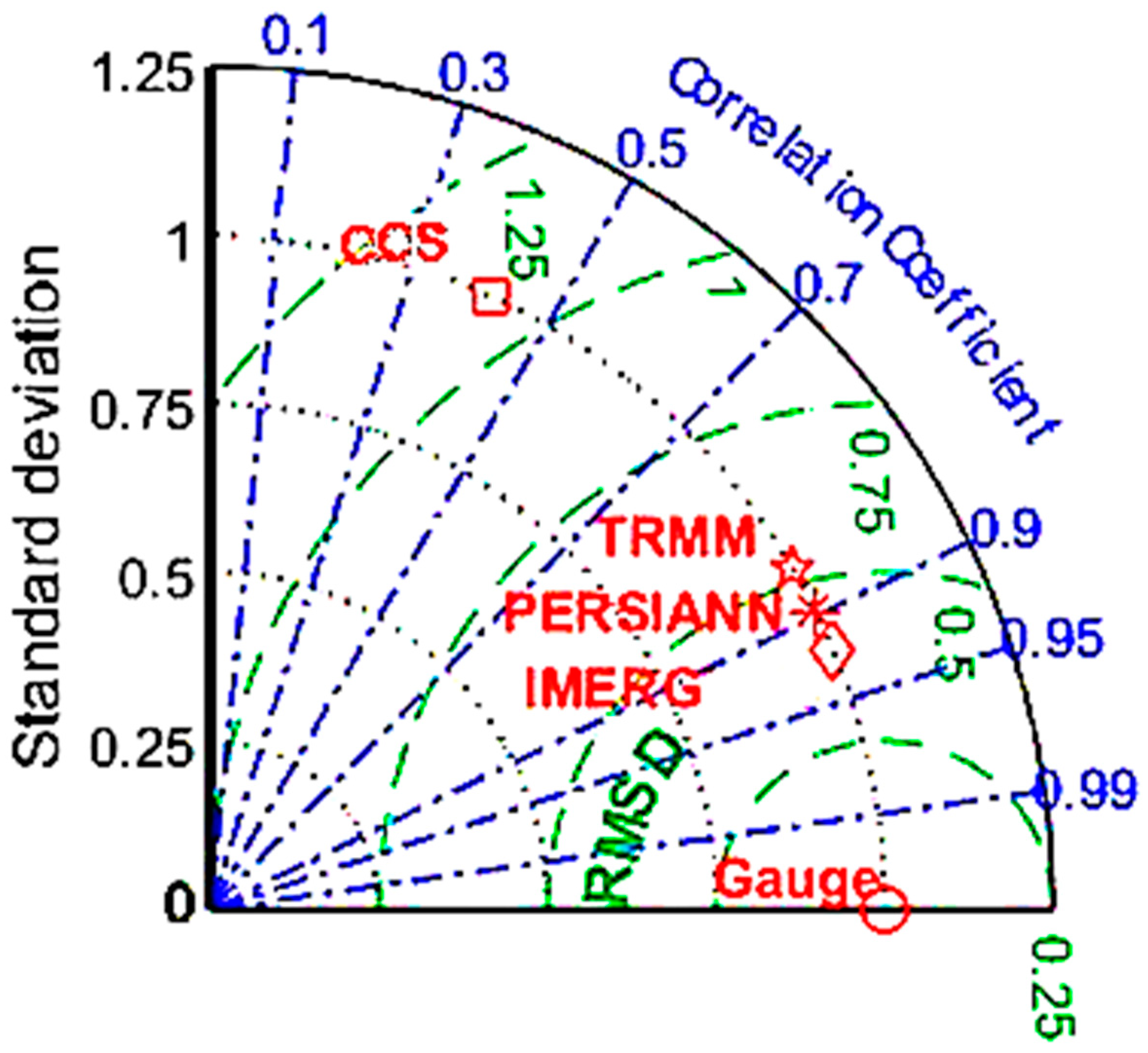
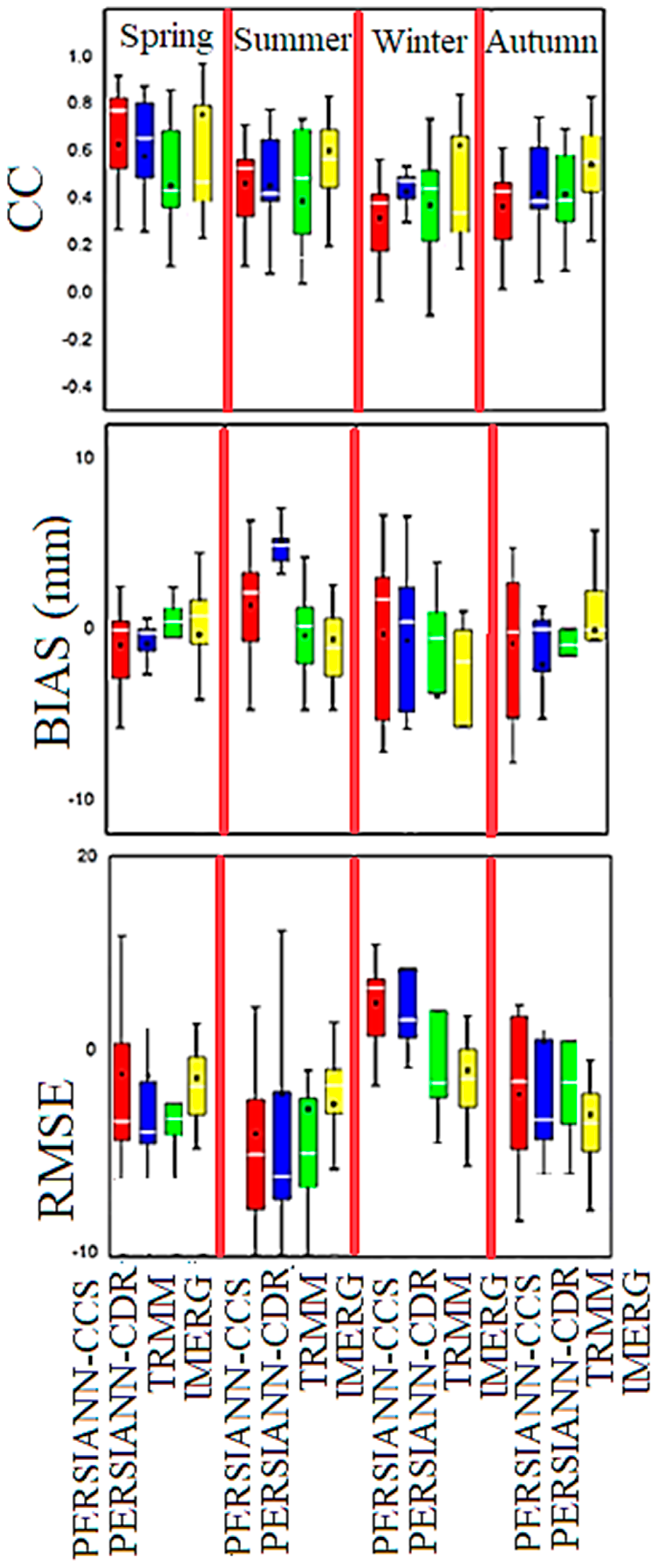
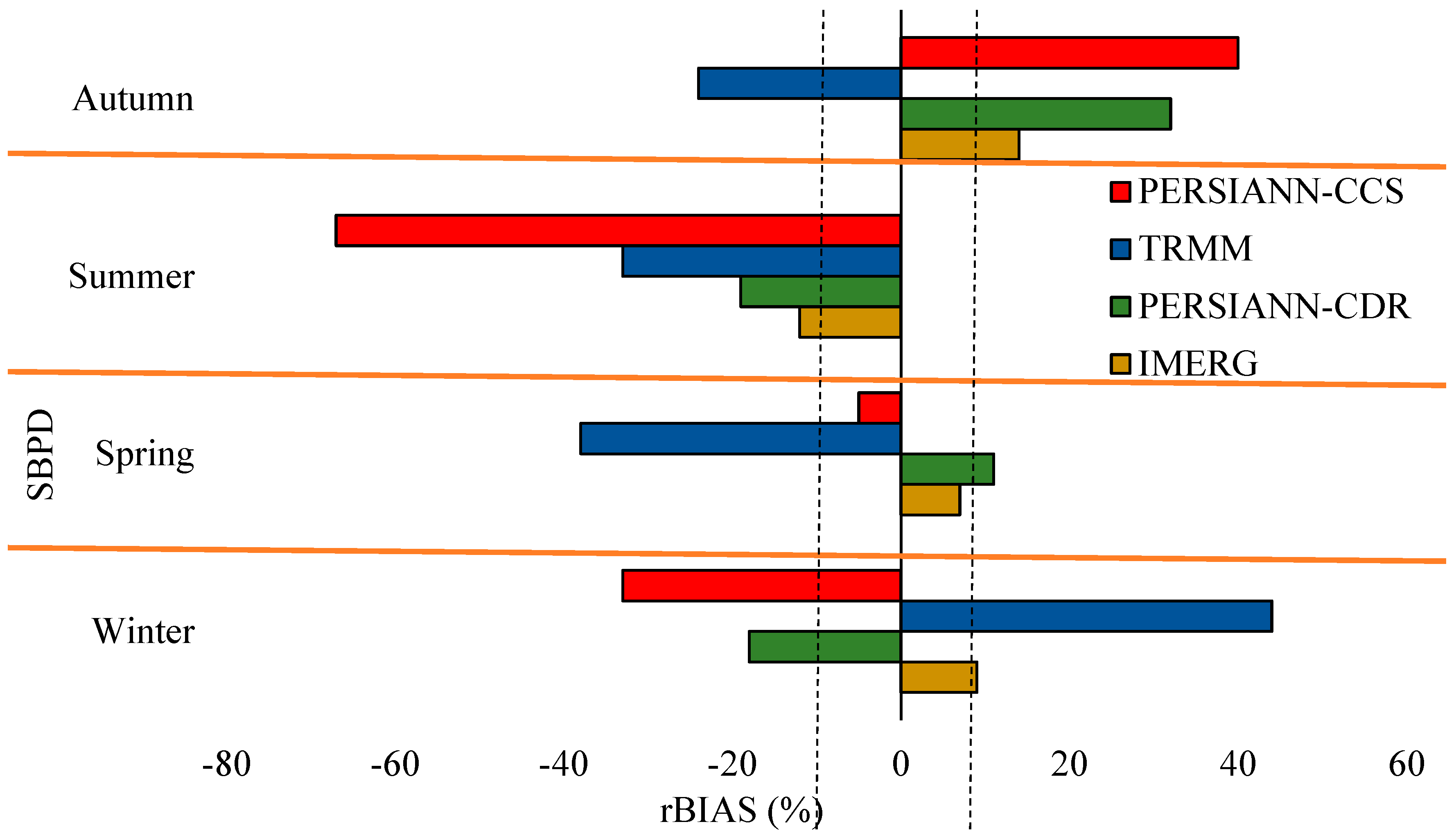
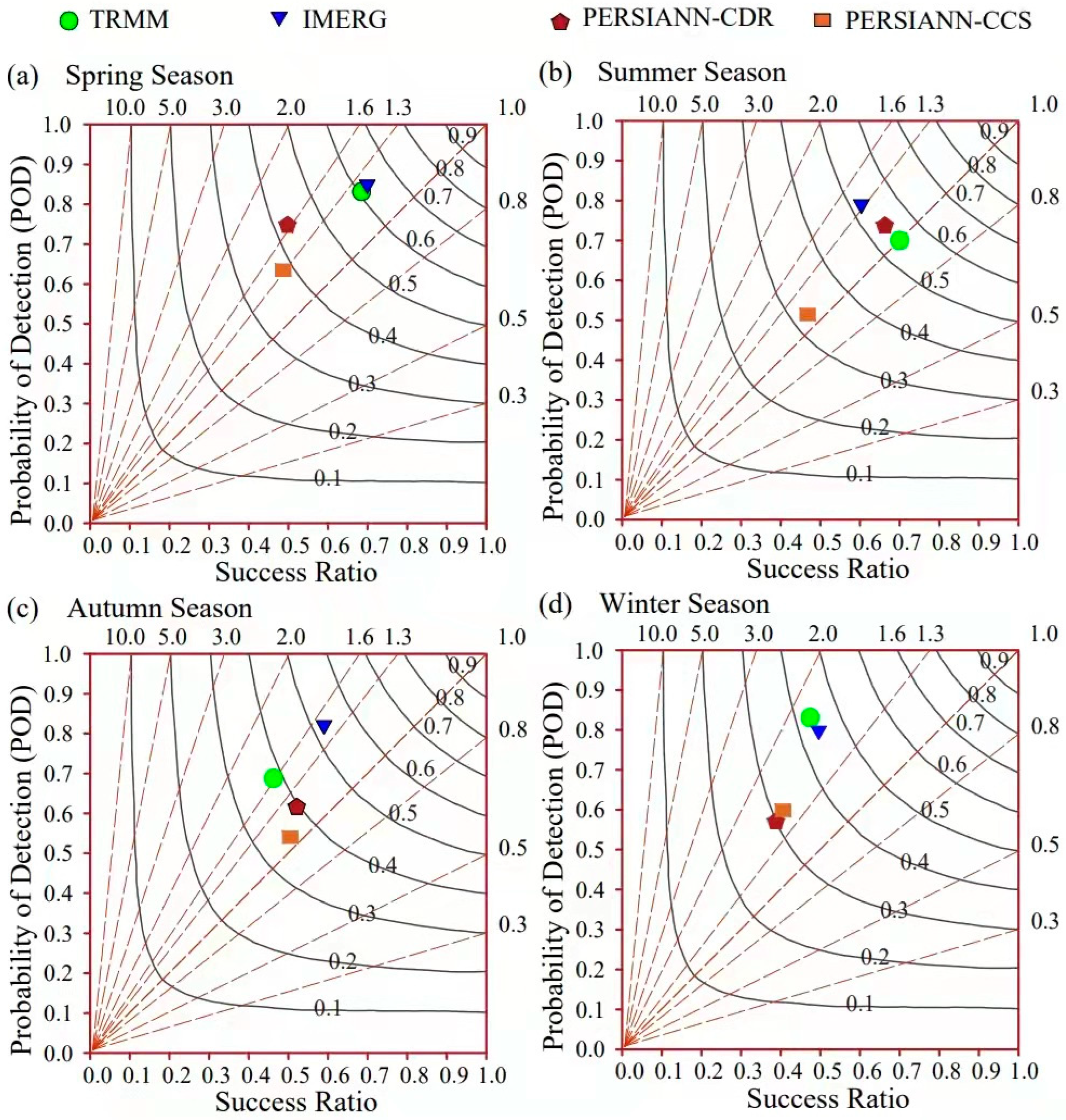

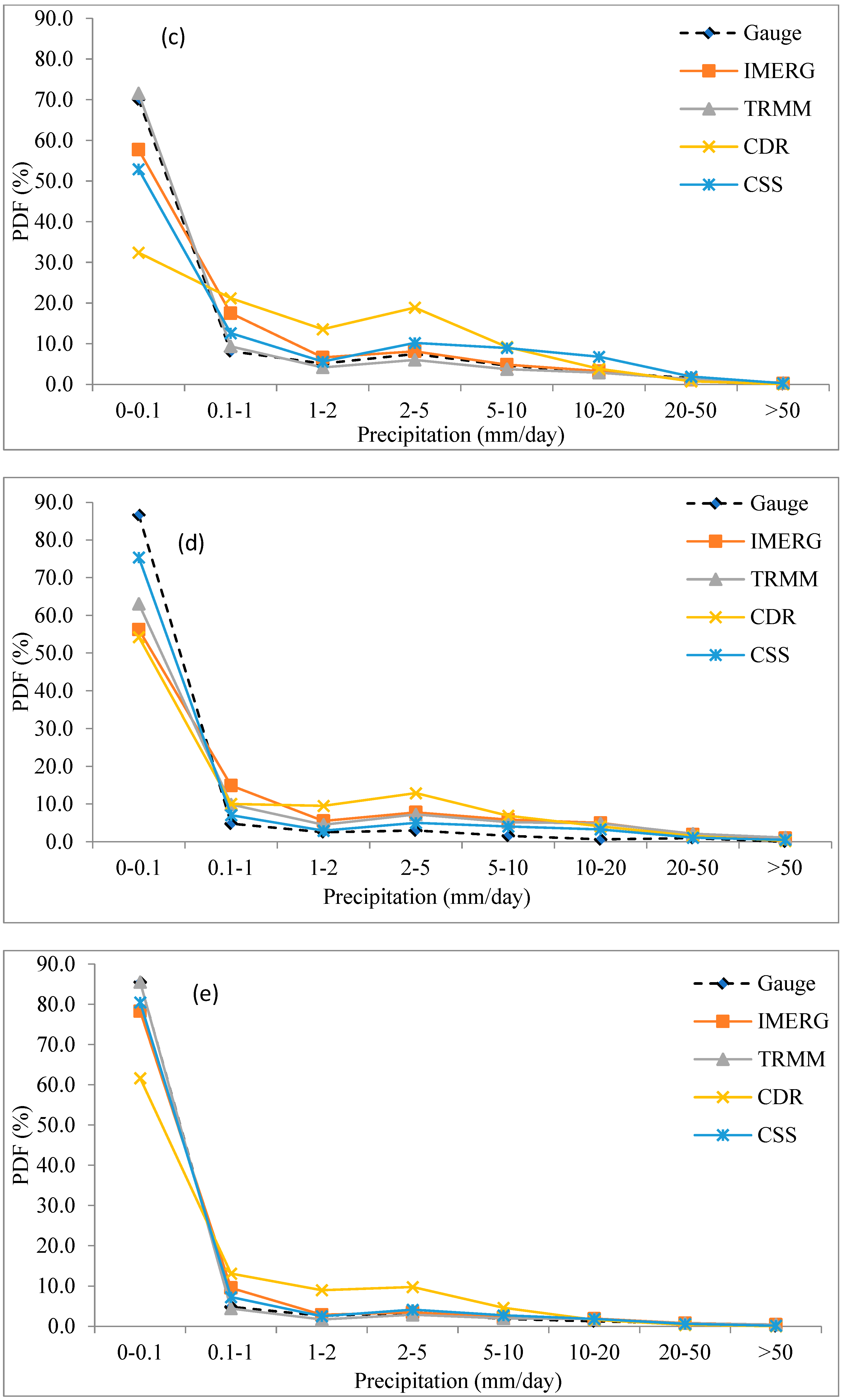
| Serial Number | Weather Station | Latitude (°) | Longitude (°) | Elevation (m) |
|---|---|---|---|---|
| 1 | Agbai Anzob | 39.08 | 68.87 | 3373 |
| 2 | Agbai Shahriston | 39.34 | 68.35 | 3143 |
| 3 | Bulunkul | 37.42 | 72.57 | 3747 |
| 4 | Darvoz | 38.47 | 70.88 | 1284 |
| 5 | Dehavz | 39.45 | 70.2 | 2561 |
| 6 | Dushanbe | 38.58 | 68.78 | 790 |
| 7 | Faizobod | 38.55 | 69.32 | 1215 |
| 8 | Humrogi | 38.31 | 71.38 | 1736 |
| 9 | Irkht | 38.17 | 72.63 | 3290 |
| 10 | Ishkoshim | 36.73 | 71.6 | 2646 |
| 11 | Javshangoz | 37.36 | 72.46 | 3576 |
| 12 | Khorug | 37.5 | 71.5 | 2075 |
| 13 | Khovaling | 38.35 | 69.95 | 1468 |
| 14 | Madrushtak | 39.43 | 69.65 | 2234 |
| 15 | Rushon | 37.45 | 71.52 | 1966 |
| 16 | Sangiston | 39.38 | 68.62 | 1502 |
| 17 | Savnob | 38.18 | 72.28 | 2800 |
| 18 | Shaymoq | 37.46 | 74.4 | 3835 |
| Satellite Datasets | Spatial/Temporal Resolution | Time Coverage | Data Source (All the Data Assessed on 13 January 2019) |
|---|---|---|---|
| PERSIANN-CDR | 0.25° × 0.25°/1-day | January 1983 to September 2023 | www.ncdc.noaa.gov/cdr/operationalcdrs.html |
| PERSIANN-CCS | 0.04° × 0.04°/1-day | January 2003 to January 2023 | ftp://persiann.eng.uci.edu/CHRSdata/PERSIANN-CCS |
| IMERG | 0.1° × 0.1°/1-day | January 1998 to December 2020 | http://pmm.nasa.gov/data-access/downloads/gms/ |
| TRMM | 0.25° × 0.25°/1-day | January 1998 to December 2020 | http://disc2.nascom.nasa.gov/tovas/ |
| Statistical Analysis | Details | Acceptable Range |
|---|---|---|
| CC = Correlation Coefficient Gi = In situ gauge data G = average of in situ gauge data Ei = SBPD of estimations E = mean of SBPD estimations n = total number of SBPD | 1 | |
| Ei = estimates of SBPD Gi = In situ gauge data n = total number of SBPD | 0 | |
| rbias = Bias, relative Bias Ei = estimates of SBPD Gi = In situ gauge data n = total number of SBPD | ±10 | |
| RMSE = Root Mean Square Error Ei = estimates of SBPD Gi = In situ gauge data n = total number of SBPD | 0 | |
| POD = Probability of Detection A = number of precipitation events that the SBPD actually tracked B = number of precipitation events that the reference gauging stations observed but were not tracked by SPBD | 1 | |
| FAR = False Alarm Ratio C = number of precipitation events that the SBPD misrepresented A = number of precipitation events that the SBPD actually tracked | 0 | |
| CSI = Critical Success Index A = Amount of precipitation events that were reported by SBPD B = Amount of precipitation events missed by SBPD while being observed by reference gauging stations C = Amount of precipitation events that were inaccurately tracked by SBPD | 1 |
Disclaimer/Publisher’s Note: The statements, opinions and data contained in all publications are solely those of the individual author(s) and contributor(s) and not of MDPI and/or the editor(s). MDPI and/or the editor(s) disclaim responsibility for any injury to people or property resulting from any ideas, methods, instructions or products referred to in the content. |
© 2023 by the authors. Licensee MDPI, Basel, Switzerland. This article is an open access article distributed under the terms and conditions of the Creative Commons Attribution (CC BY) license (https://creativecommons.org/licenses/by/4.0/).
Share and Cite
Gulakhmadov, M.; Chen, X.; Gulakhmadov, A.; Nadeem, M.U.; Gulahmadov, N.; Liu, T. Performance Analysis of Precipitation Datasets at Multiple Spatio-Temporal Scales over Dense Gauge Network in Mountainous Domain of Tajikistan, Central Asia. Remote Sens. 2023, 15, 1420. https://doi.org/10.3390/rs15051420
Gulakhmadov M, Chen X, Gulakhmadov A, Nadeem MU, Gulahmadov N, Liu T. Performance Analysis of Precipitation Datasets at Multiple Spatio-Temporal Scales over Dense Gauge Network in Mountainous Domain of Tajikistan, Central Asia. Remote Sensing. 2023; 15(5):1420. https://doi.org/10.3390/rs15051420
Chicago/Turabian StyleGulakhmadov, Manuchekhr, Xi Chen, Aminjon Gulakhmadov, Muhammad Umer Nadeem, Nekruz Gulahmadov, and Tie Liu. 2023. "Performance Analysis of Precipitation Datasets at Multiple Spatio-Temporal Scales over Dense Gauge Network in Mountainous Domain of Tajikistan, Central Asia" Remote Sensing 15, no. 5: 1420. https://doi.org/10.3390/rs15051420
APA StyleGulakhmadov, M., Chen, X., Gulakhmadov, A., Nadeem, M. U., Gulahmadov, N., & Liu, T. (2023). Performance Analysis of Precipitation Datasets at Multiple Spatio-Temporal Scales over Dense Gauge Network in Mountainous Domain of Tajikistan, Central Asia. Remote Sensing, 15(5), 1420. https://doi.org/10.3390/rs15051420











